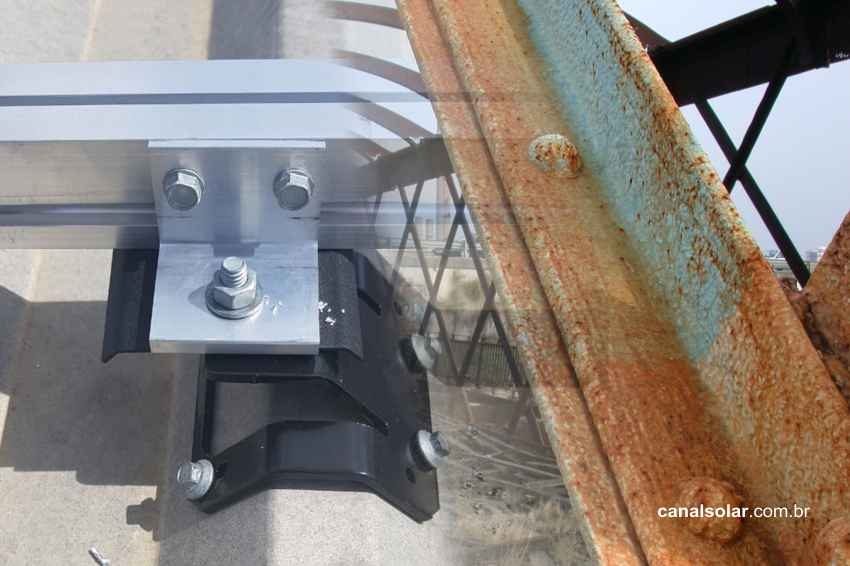In this article, we will address the anti-corrosion surface treatments used on the metal structures of photovoltaic systems.
The causes of material corrosion were investigated in the article Galvanic corrosion in metal structures of photovoltaic systems.
Now, let's focus on the treatments used to prevent corrosion of structural and fixing metal parts and parts in installations.
Two anti-corrosion treatments are very common and already known in many industrial applications, including in the photovoltaic segment: aluminum anodizing and steel galvanizing.
Recently, some alternative solutions have emerged on the photovoltaic market with the phosphating, cathodic electrophoresis (KTL) and Geomet processes.
These processes, which have been used for many years in the automobile, naval and aeronautical industries, promise to provide high durability and good cost-benefit in photovoltaic installations.
The protective layer created by surface treatments has the primary function of preventing bimetallic corrosion due to the presence of the electrolyte, typically formed by humidity in the air or rain, by residues and above all the salinity of the sea in coastal locations.
With the isolation between metals, the galvanic cell is not formed, thus interrupting the exchange of electrons, the generation of ions and galvanic corrosion. The surface films also isolate the material from contact with air, preventing oxidation and rust (a common problem with ferrous metals).
Below, we list and summarize the main anti-corrosion surface treatment techniques that can be used on photovoltaic metal structures. Metallic structures should be avoided for fixing photovoltaic modules that do not employ at least one of the techniques described below.
Photovoltaic systems are designed to have a lifespan of more than 25 years. In addition to the long expected useful life, providing greater economic return for the owner, the safety factor must also be considered. Photovoltaic modules with deteriorated and corroded fixings can cause a serious safety risk, with the possibility of modules being torn off and falling during windstorms.
Anodizing
This technique applies exclusively to aluminum parts. It is an electrochemical process that adds a film layer of metallic oxide, providing an insulation barrier between the aluminum and the external environment, which prevents contact with other metals and prevents corrosion.
Aluminum is already highly sought after as it is a metal that does not rust easily, as it has a natural insulating oxide layer (which appears when aluminum comes into contact with air) that makes it naturally less reactive. In other words, unlike ferrous metals, aluminum becomes less likely to oxidize in air later as it acquires a naturally created surface layer of oxide.
In the case of anodized aluminum, the metal receives an additional layer of oxide through an industrial process, much thicker than the natural film. Anodizing can also provide a perfectly sealed, non-porous oxide layer, which provides high durability to the structures.
In addition to being naturally not prone to oxidation and corrosion, aluminum is light and malleable, which makes it very attractive for photovoltaic structures. A negative aspect is the cost, which makes aluminum structures relatively more expensive than steel structures.

Galvanization
Without a doubt, galvanization is the best-known and most used technique in metallic structures for various applications, especially when looking for low cost and durability, which can be very long, depending on the quality of the treatment and the conditions of use.
Galvanizing is nothing more than applying a layer of zinc to a ferrous material, such as steel. Steel is the metal alloy most used in construction and industry, in all types of applications, due to its wide availability, its relatively lower cost (than aluminum, for example) and its excellent mechanical properties.
Steel has the disadvantage of being a material prone to oxidation in contact with air and water. The oxidation of steel (and other ferrous materials) in a more aggressive stage causes the appearance of iron hydroxide, a reddish substance that we know as rust.
To avoid the oxidation process, as well as the bimetallic corrosion process (of steel in contact with other metals), the zinc plating or galvanization process is widely used in industry. The best-known process is hot-dip galvanizing, which consists of immersing metal parts in a bath of molten zinc.
In addition to promoting the isolation of the steel from the air, which prevents oxidation, the zinc layer also eliminates bimetallic corrosion by preventing the steel from coming into contact with other metals. Furthermore, if conditions exist for steel corrosion (for example, if the zinc surface is damaged) the zinc will function as a sacrificial electrode or anode. This means that the zinc will corrode in place of the steel, preserving the steel and keeping it intact.
The sacrifice of zinc occurs because it is more electropositive (or less electronegative) than other metals, including steel. Its ability to donate electrons is very high, so if steel and zinc are close together, the latter will be more prone to corrosion.
The durability of galvanized steel structures depends on applying the correct thickness of zinc. The fire resistance of galvanic zinc surface treatments is directly linked to the applied layer thickness. The installation location is another determining factor. If we consider a useful life of 25 years, desirable in photovoltaic systems, in urban areas the zinc finish must have a layer of at least 60 μm (micrometers).

Phosphating
Phosphating is a process that coats the surface of steel with zinc phosphate or zinc compounds. This treatment increases the corrosion immunity of steel parts. Zinc phosphating is the most used on the market and is intended for a large number of applications. This treatment is widely used to prepare the surface to receive painting or another type of surface treatment.
Among the numerous variations of the process, tricationic phosphating consists of a mixed process using zinc, nickel and manganese or calcium phosphate. This process is widely used in the automobile industry as it offers great resistance to corrosion and good adhesion for painting, which makes the surface ready to receive other treatments.
Tricationic phosphating is widely used in the preparation of metal parts for electrophoretic painting, which is the subject of the next item.
Cathodic electrophoretic paint (KTL)
Cathodic electrophoretic treatment, known as KTL, is a type of treatment known as E-coat. The name KTL originates from German Kathoden-Tauch Lackierung, which means cathodic immersion painting in free translation. E-coat is the generic name given to an electroplating painting process, which is a surface treatment (or painting) by immersing metal parts in an aqueous medium with resins and organic pigments.
E-coat offers a high degree of anti-corrosion protection, being a process widely used in the automobile and aeronautical industries. The cathodic electrophoresis E-coat (KTL) technique uses an electric field to impregnate the surface with the protective film in an aqueous medium. Before receiving pigmentation, metal parts must go through the previous phosphating process.
The advantage of KTL in the photovoltaic industry is the replacement of aluminum by steel in some structural parts, especially in the fixing supports for aluminum rails. While aluminum continues to be the preferred metal for manufacturing mounting rails for photovoltaic modules, the use of KTL-coated steel parts has the advantage of providing cost reduction and increasing the mechanical strength of the fixings, as steel supports more stress. than aluminum.
The KTL technique allows the perfect combination of steel and aluminum parts in photovoltaic structures. According to this process, steel parts, in addition to phosphating (which is already an excellent anti-corrosion treatment), receive an extra layer of uniform organic pigmentation with a thickness that varies between 20 μm and 80 μm.
This organic paint provides superior protection against corrosion. In addition to preventing steel from coming into contact with other materials or the external environment, organic paint is electrically insulating and practically eliminates the occurrence of galvanic batteries.
The KTL coating is a good suggestion for application to parts that interface different materials in photovoltaic installations. For example, an aluminum rail or a photovoltaic module supported on a galvanized steel structure or tile.
The metal support that fixes the rail or module prevents the aluminum from coming into contact with the rest of the structure or the galvanized steel tile, offering absolute immunity to bimetallic corrosion and providing great durability for the installation.
Geomet
Geomet is an organometallic anticorrosive treatment. It is a type of E-coat with patented substances based on zinc and aluminum. The name Geomet is a registered trademark of NOF Metal Coatings (USA), which has a subsidiary in Brazil. The company specializes in high-performance anticorrosive coatings.
Geomet is applied by immersion, centrifugation or spray. After a period of curing, the metal parts acquire a greyish metallic coating, which is very adherent and resistant. The process can be applied to protect iron, steel or aluminum parts, according to specific formulations of the reagents used in the aqueous solution.
The main benefits of Geomet are the high degree of protection with a minimum thickness application layer, without practically altering the original dimensions of the metal part. This characteristic is important for application in screws, for example, without interfering with the thread characteristics (with preserved dimensions and controlled friction coefficient).
Geomet's corrosion resistance is superior to that of traditional galvanizing coatings. Despite being conductive, the Geomet film is non-reactive and does not cause bimetallic corrosion in contact with steel or aluminum. Geomet's superiority can only be matched by the KTL process, which is a process that also presents high performance in corrosion protection, as we mentioned above.
In the photovoltaic segment, Geomet is recommended for washers, nuts and screws. In photovoltaic installations, it is very common to find galvanized steel screws and washers that are oxidized and corroded even after a short period of use, even in dry, non-coastal locations.
Geomet solves this problem, as it provides high anti-corrosion protection for steel screws and accessories, replacing galvanization. The use of screws with Geomet has become very common in various segments of the industry and the photovoltaic sector can greatly benefit from this technology, especially due to the great exposure of photovoltaic structures to bad weather, humidity and salinity.
The combination of Geomet (on screws) and KTL (on supports and fasteners) provides long durability and unparalleled protection against any type of corrosion.




















One Response
The issue is not the structures, but the panels themselves, which are affected by moss in coastal regions and lose their power generation capacity! Is there a solution?